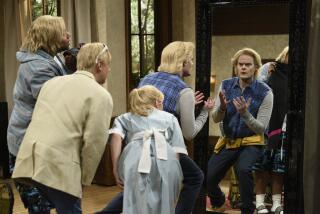The New Yorker Draws a Blank
- Share via
The drawing is of a man behind a desk that has nothing on it but a phone and two sheets of paper. Behind him is a large window looking out on palm trees and a jagged mountain. He is wearing a sports jacket over an open-necked sports shirt, and, though inside, has sunglasses on.
“Look, babe,” the man is saying. “At this point, you’ve reinvented yourself so many times you’re back to who you were at the start.”
Quiz question: How many hackneyed California references can you find in a single image?
The cartoon, one of 16 in the latest issue of the New Yorker, is supposed to be making sport of California, the subject of the magazine’s double issue on the state. But like most of the rest of the cartoons, its vision of what makes a Californian seems horribly tired and cliched.
The New Yorker cartoon has long been regarded as one of the country’s most sophisticated critical art forms. But for some reason, in its homage to California this time around, its cutting-edge teeth are dull and in need of flossing. The stereotypes of Californians in many of the cartoons are not only sophomoric, but also hopelessly outdated.
There are wine drinkers in hot tubs, neighbors ferreting out fake Rolexes and guys in ponytails talking on cell phones at outdoor cafes. The captions are filled with terms most Californians--at least ones who remember it is the 1990s, not the 1960s--would shun: “technobabble” and “spiritual growth” and “inner peace.”
“They are just all stereotypical characterizations of the way other parts of the country tend to think of California,” said Stanford political science professor Luis Fraga, who studies California culture. “They more accurately are a characterization of Hollywood in the 1930s and 1940s. It’s unfortunate because there are a lot of things you can make fun of here in California today.”
Unlike the cartoons, there are some splendid articles in the issue, including pieces on Proposition 209, a visionary think tank in Silicon Valley and a beautiful essay on the light of Southern California.
But then, in another cartoon, an alleged executive sits at his desk. Again, nothing is on it except a phone, a desk lamp and photograph (i.e., no one works in La-La Land). Behind him is a picture window with a palm tree in view (i.e., California, the idle idyll). Across from the boss sits a man with a ponytail and ascot (i.e., only silly looks allowed here). The boss says, “Damn it, Henderson, New York is still three hours ahead of us. Get on that!”
Damn it, New Yorker, your cartoons are 30 years behind us. Get on that!
“One shouldn’t be surprised, I guess. My approach to the New Yorker is, why should I take them seriously when they refuse to take California seriously,” said Michael Dare, director of the USC’s Southern California Study Center. “They don’t want to grasp what is going on around here--both the vibrance and the foolishness--so they draw on these old cartoons and images of an aged version of what Easterners suppose California to be.”
“I was raised in New York and Nancy is from L.A., but we’re bringing up the children bicoastal,” says a man in one cartoon. In another, a unisex someone in a Hawaiian shirt walking a dog on a beach says to a driver looking for directions, “OK, this is the West Coast, OK? What you want is the East Coast, so turn around and go back 24, 25-hundred miles, and that’s the East Coast. You can’t miss it.”
OK. OK? Get it? Or did they miss it?
Cliched Hollywood does heavy duty in the cartoons. Christian Slater causing an earthquake; Demi Moore gaining 200 pounds to play Kate Smith (OK, so there is something funny); more guys in ponytails and sunglasses with cell phones; an out-of-date reference to NBC’s worry over the renewal of “E.R.”
In fact, from a New Yorker cartoon perspective, “California” pretty much stops at the Ventura County line.
“Has Northern California seceded? The Central Valley? San Francisco? Silicon Valley? Surely, there is a good new joke there somewhere,” Dare said.
Surely, there is. But not in the current issue of the New Yorker.
More to Read
The biggest entertainment stories
Get our big stories about Hollywood, film, television, music, arts, culture and more right in your inbox as soon as they publish.
You may occasionally receive promotional content from the Los Angeles Times.










